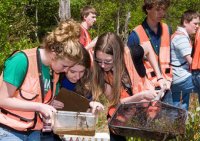Where in the World Will You Go Next with PBL?
Previously in this series on going deeper with project-based learning, we've explored the importance of teacher reflection in teacher reflection in PBL, considered how to plan interdisciplinary projects, and talked about technology integration strategies. All offer practical ways to extend the benefits of PBL.
Today, let's think about taking project-based learning beyond your classroom and connecting you and your students with the wider world.
Why Go There?
Why would you want to expand projects beyond your own school setting? If you're new to PBL, you may be thinking, "I already have my hands full managing what's happening in my own classroom!"
Maybe so, but watch what happens when teachers take the next step with PBL. Whether they collaborate on global education projects or use a tool like Skype to connect students with experts outside of school, they report a wide range of benefits. Students develop a global perspective when they have meaningful opportunities to interact with peers from other parts of the world. They're more engaged in learning when they tackle real challenges, whether in their own communities or around the world.
Collaborative projects broaden teachers' horizons, too, connecting them with colleagues from around the world. Vicki Davis (@coolcatteacher) and Julie Lindsay (@julielindsay), founders of the Flat Classroom Project, had never met face-to-face when they launched their first collaborative project several years ago. Now, they have co-authored a book, Flattening Classrooms, Engaging Minds to share their field-tested insights about collaborative PBL. They lead teachers from around the world on several "flat" projects annually, using technology to overcome distances and connect learners in shared inquiry and problem solving.
Start Small, Build Out
The good news is, there's plenty of support to help you get started with collaborative PBL. Global networks like ePals, iEARN, and the popular Monster Project invite you to join existing projects. That means you don't have to start from scratch. You can learn alongside PBL veterans, adapting their project plans to meet the needs and interest of your students.
Taking IT Global is a hub for connecting students who share a passion for global citizenship.
On a smaller scale, teachers are using networks like QuadBlogging to connect classrooms and make sure students have authentic audiences for project work. (Read more about this idea in "QuadBlogging Connects Student Writers with Global Audiences.")
If you're thinking about extending the reach of your next project, here are a few more strategies and resources to help you get started.
Look for Common Ground
At the recent Partners in Learning Global Forum in Prague, I talked with several teachers from the Middle East and Africa who are launching a project that they have designed together. Their approach shows the value of looking for common ground when collaborating on a project across distances.
Although these teachers come from several countries and work with students of varying ages, they have found an issue that affects public places everywhere. In a word: graffiti. Their joint project, "Stop Defacing Our Monuments," enlists students as cultural ambassadors who will step up to preserve their national monuments from vandalism in Lesotho, United Arab Emirates, Lebanon, South Africa, Nigeria, and Seychelles.
Teachers hope to inspire students to think about what's "monument-worthy" in different places. What stories do their national monuments tell about their cultural heritage? What's causing people to deface these monuments? How is the experience in one country different from what students are reporting in other places?
Academic content in a project like this could range from history and art to math and chemistry. It's up to each teacher to decide on the key learning goals for his or her students. High school chemistry students in Lebanon, for example, will be investigating the best solutions for removing graffiti without destroying materials like bronze or marble. Their expertise may end up helping students in Nigeria or South Africa design their clean-up strategies. Across cultures, students will produce rap videos to spread their anti-graffiti message and kick off a global clean-up effort. (Teachers offer a preview of the project in this YouTube video.
Resources to Help
For more ideas about collaborative PBL, check out these resources:
- #Comments4Kids is a Twitter hashtag you can use to invite educators from around the world to comment on your students' project blogs
- The Journey North is a collaborative inquiry project about seasonal change. Students observe seasonal migrations and report their data to a global community of young scientists
- The Center for Innovation in Engineering and Science Education sponsors global, interdisciplinary projects. In a project coming up in the spring, for example, students will use solar and LED technologies to produce model lighting systems for use in developing countries
- Skype in the Classroom enables teachers to connect their students with content experts via free videoconferencing
Where in the world do you plan to go next with PBL? Please tell us about your global learning adventures.
